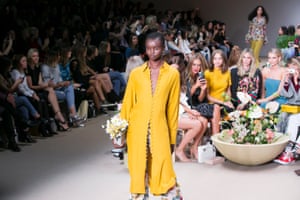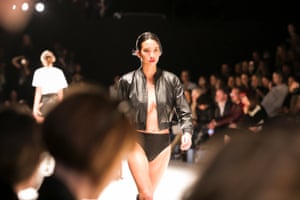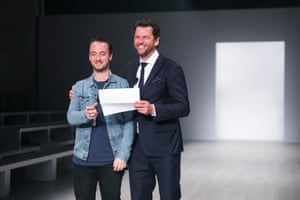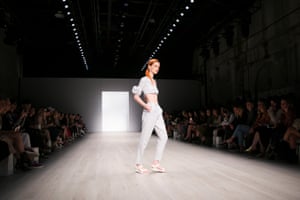
In 1985, Donna Karan launched a collection centered on what she called her seven easy pieces. It offered working women a stylish, flattering capsule wardrobe that could be simply mixed and matched for a variety of looks—and a solution to the perennial problem of what to wear to the office.
The “easy” part was very much the point. In US offices, the suit, or at least a button-up and nice trousers, was the men’s uniform. Women’s work dress wasn’t easy at all: Women were expected to be feminine but not too feminine, creating a variety of ways their outfits could go wrong. Too bright, too tight, too dowdy, too sexy, too masculine—all were potential pitfalls. “Easy” did not describe getting dressed for women at the time.
Today it still doesn’t, but for new reasons. Women have made strides in the workplace, but there is no longer any dominant office dress code in the US. Conservative sectors, such as finance and law, may be slowly loosening up, but they still often require fairly formal clothing. Silicon Valley, meanwhile, is a bastion of informality, home of the business hoodie. In between those two poles are any number of offices that fall at different points along the corporate-to-casual spectrum. “Work clothes” no longer just means suits, blazers, starched shirts, and tailored trousers. The situation can make it difficult for anyone to get a handle on what is and isn’t right for the office.
It seems an opportune moment for a designer to come along with a new set of seven easy pieces for women. But as of right now, brands such as Anne Klein, Ann Taylor, Banana Republic, J.Crew, and others that have long sustained themselves by providing women with work clothes are failing to make the situation much easier. They’re being pulled in different directions, or can’t provide any compelling vision of how a modern women’s work wardrobe should look. Many are struggling to keep themselves, and workwear, relevant.
It’s a delicate balancing act. Too much fashion is often given as one of the reasons for J.Crew’s dismal performance in recent years as well. But then an outdated or indistinct design identity isn’t any better, as the struggles at Ann Taylor and Banana Republic prove.
Women trying to shop at these stores clearly don’t seem to be able to find what they’re looking for, or sales would be better than they are. Meanwhile, many are confused about what’s appropriate in different office environments. The increasing freedom to choose one’s clothes may actually be making it more complicated for many women to decide what’s appropriate for work.
Work clothes are polarizing
DKNY—the more affordable, youthful offshoot of Donna Karan launched in 1989—exemplifies one of the challenges of designing a modern wardrobe for women. After Karan left her business in 2015, effectively shuttering the premium label, DKNY carried on under two recently enlisted New York fashion talents who tried to update it for the current moment. They mixed classic tailoring with streetwear and sporty athleisure.
The blend of sportswear and tailoring was always part of the Donna Karan DNA, but instead of one coherent vision, the new look often felt like two separate wardrobes that were too far apart stylistically. Was it for the 30-something professional dressing for a career, or a 20-something looking for streetwear? The attempt faltered, and the designers left last year. DKNY’s owner, LVMH, sold the brand to the apparel group G-III.
https://www.instagram.com/p/BQnyIIfgpTy/embed/captioned/?cr=1&v=7&wp=500#%7B%22ci%22%3A0%2C%22os%22%3A14286.995%7D
The challenge of being on-trend while also serving a working audience is one many brands are grappling with, according to Kat Griffin, founder of Corporette, a popular blog about women’s work clothes. “The problem for a lot of these workwear companies that have always been the stalwarts—and the ones that my readers have loved and relied on—is they are trying to move with the trends, even though a conservative office today still looks very similar to 10 years ago,” she says. “The athleisure trend, the ripped-denim trend, all the different trends that you see at more casual offices are still largely inappropriate for conservative banks or law firms or places like that.”
It’s true that conservative offices have loosened up some, but only some. Meanwhile, many other offices have rapidly lost their formality, to the point that there’s often no distinction between what a woman might wear during the week versus out for the evening or on the weekend.
What, then, should brands that want to provide women with their work clothes be selling?
Casual clothes are eating workwear
The underlying traits that define office clothing haven’t varied too much. For women (and men), clothes should probably not be too revealing, or too sloppy. But our baselines for what those things mean keep moving. The line between athletic clothing and everyday clothing, for instance, continues to blur, and leggings have become part of many women’s basic wardrobes. Now they’re becoming part of what women wear to work, too.
Fashion editors have varying opinions on whether leggings are ever appropriate for work. Some say it’s a flat-out no. But as a spokesperson for Birchbox, a popular beauty-product subscription service, told Today.com, they’re already a common sight in their office.
Leggings may be an extreme example of how casual workplaces have gotten. But they underscore the point that a closet full of suits and other more formal attire is no longer necessary, and that workwear brands ignore casual clothes at their peril. Sales of tailored clothing for women keep shrinking, while sports-inspired clothing—the athleisure Griffin referred to—is carrying the global apparel industry. According to data from research firm Euromonitor, the US market for women’s suits shrank by about 77% between 2007 and 2016, while the market for leggings more than quadrupled.
This shift is having clear effects. J.Crew, which resisted the rise of athleisure, finally gave in last year and launched a collection with New Balance. Within Gap’s portfolio, Banana Republic, which has long focused on work clothes, continues to suffer, while activewear remains a top performer, as CEO Art Peck noted on a recent earnings call.
Griffin says she’s found that many retailers have reduced their suiting selections in stores, or moved them entirely online, where they frequently show the items as separates, so a woman may not know if a blazer has a matching skirt or pants. Corporette’s core audience of women lawyers complains about struggling to find places to shop.
Fashion is eating workwear, too
This move toward casual clothes also means workwear brands are now competing directly with quicker, cheaper fast fashion. They scramble to keep up with the rapid turnover of fashion trends, but that’s potentially problematic in itself.
“I heard for years from friends, ‘I can’t find anything to wear,’” Anne Klein’s new CEO, Liz Fraser recently told the Washington Post(paywall), explaining how she plans to reinvigorate the classic workwear label. “They wanted more style and less fashion.”
In this context, “fashion” usually refers to trend-driven clothes and items with unconventional design, while “style” means basics and pieces not so closely associated with a specific moment. Take, for instance, the off-the-shoulder tops that have steadily been cropping up everywhere, including retailers such as Ann Taylor. Even at informal offices, the style could show off too much skin for some. “If you need a special bra for it, it’s not office wear,” Griffin says.
https://www.instagram.com/p/BTO_adhhVra/embed/captioned/?cr=1&v=7&wp=500#%7B%22ci%22%3A1%2C%22os%22%3A14300.995%7D
Workwear brands are in a difficult position. The retail market moves faster than ever. If they don’t keep up, they may miss out on attracting new customers. But change too much, and they risk alienating old ones.
And women are left with the same problem each morning, of what to wear to work. “This is why you see more and more women choosing capsule wardrobes,” Griffin says.
She’s speaking of companies such as MM.LaFleur, which are trying to solve the problem by stripping work clothes to their most basic, and even removing shopping from the equation. After you fill out a questionnaire with information about your office dress code—business formal, business casual, casual, fashion-forward—your profession, job title, and age, MM.LaFleur will send you a “Bento Box of office-appropriate staples.”
Each box contains four to six pieces, which may include separates, dresses, knits, and accessories. It makes knowing what to wear, and getting it, easy, kind of like Donna Karan’s seven easy pieces once did.
https://www.instagram.com/p/BPxQ5VTAzge/embed/captioned/?cr=1&v=7&wp=500#%7B%22ci%22%3A2%2C%22os%22%3A14307.995000000003%7D
Last year, FastCompany ranked MM.LaFleur top in its list of companies making women’s lives better, a testament to the company itself but also an acknowledgement of the challenge that dressing for work is for many women today.
DEALMAN































































